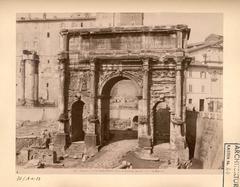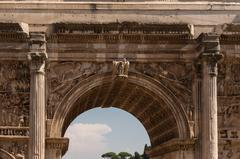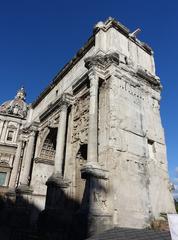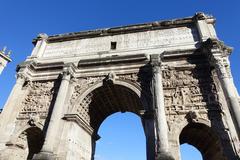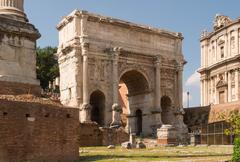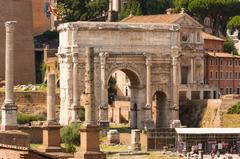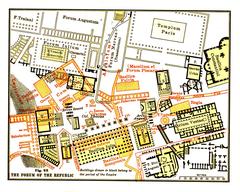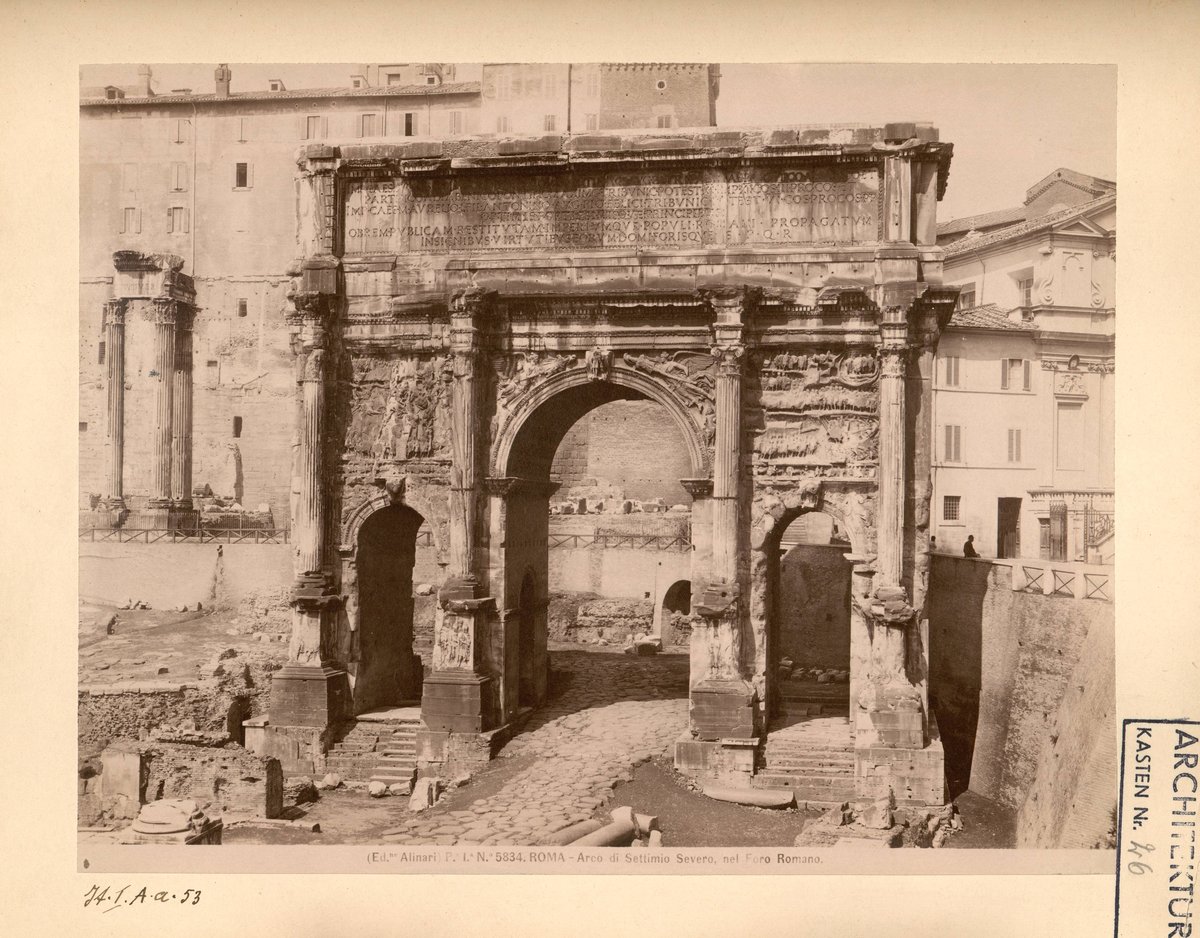
Arch of Septimius Severus Rome: Visiting Hours, Tickets, and Historical Significance
Date: 14/06/2025
Introduction
The Arch of Septimius Severus stands majestically at the northwest end of Rome’s ancient Roman Forum. Erected in 203 CE, this monumental triumphal arch commemorates Emperor Septimius Severus’s military victories in the Parthian campaigns and serves as a vivid symbol of Roman imperial power and artistry. With its triple arches, towering Corinthian columns, and intricate reliefs, the Arch is both a testament to Rome’s architectural ambition and a piece of living history—making it an essential destination for anyone exploring the Eternal City’s imperial past (Italy Travel Secrets, World History Edu, Madain Project).
This guide provides a comprehensive overview of the arch’s origins, artistic features, visitor information, accessibility, nearby attractions, and practical travel tips—ensuring you make the most of your visit to one of Rome’s most iconic historical sites.
Table of Contents
- Historical Background
- Architectural Features and Artistic Reliefs
- Visiting Hours and Ticket Information
- Accessibility and Visitor Tips
- Nearby Attractions
- Photography and Special Events
- Frequently Asked Questions (FAQ)
- Visual Gallery
- Conclusion and Call to Action
- Further Reading and Official Resources
Historical Background
Commissioned by the Roman Senate in 203 CE, the Arch of Septimius Severus was built to honor the emperor’s decisive victories over the Parthians between 194–199 CE. These campaigns resulted in the capture of key cities, such as Ctesiphon, and the establishment of the Roman province of Mesopotamia (Totally History). The arch not only celebrated military success but also reinforced the legitimacy and power of the Severan dynasty, prominently featuring both of Severus’s sons, Caracalla and Geta.
A striking example of Roman imperial propaganda, the arch’s inscriptions and reliefs originally honored both sons. However, following Geta’s assassination by Caracalla in 211 CE, his name and image were systematically removed—a process known as damnatio memoriae (Imperium Romanum).
Architectural Features and Artistic Reliefs
Layout and Dimensions
The arch is a triple-bayed structure, standing approximately 23 meters high, 25 meters wide, and 11 meters deep. It is constructed primarily from white marble and rests on a substantial travertine base (Madain Project, Nomad Epicureans). A large central passageway is flanked by two smaller arches, all framed by pairs of free-standing composite Corinthian columns.
Decorative Reliefs
The arch is renowned for its richly sculpted relief panels:
- Attic Panels: Four large reliefs on the attic depict scenes from the Parthian campaigns, including sieges, battles, and surrender ceremonies. These panels are dynamic and detailed, capturing the drama and triumph of Roman warfare (Smarthistory).
- Spandrel Reliefs: The spaces above the arches feature winged Victories (Nike figures) holding trophies and laurel wreaths, symbolizing triumph and divine favor.
- Inner Passage Reliefs: Inside the archways, panels continue the narrative, showing the emperor addressing his troops, besieging cities, and receiving ambassadors.
Inscriptions and Symbolism
The attic bears the main dedicatory inscription, once featuring both Caracalla and Geta. The erasure of Geta’s name is still visible—a direct and rare glimpse into the political machinations of ancient Rome.
Artistic and Cultural Impact
The arch’s design, reliefs, and coffered vaults influenced subsequent triumphal arches in Rome and elsewhere, including the Arch of Constantine and Paris’s Arc de Triomphe. Its combination of historical narrative, mythological figures, and innovative engineering exemplifies the height of Roman artistry and statecraft (Imperium Romanum).
Visiting Hours and Ticket Information
The Arch of Septimius Severus is located within the Roman Forum archaeological site. Entry is included with a standard Roman Forum ticket, which also covers the Colosseum and Palatine Hill (Parco Archeologico del Colosseo).
-
Opening Hours:
- Open daily from 8:30 AM
- Closing times vary by season:
- March–August: 7:15 PM
- September: 7:00 PM
- October: 6:30 PM
- November–February: 4:30 PM
- Closed on December 25 and January 1
-
Ticket Prices (2025):
- Adults (18+): €72
- Children (up to 17): €45
- EU citizens aged 18–25: discounted rates available
- Tickets valid for two consecutive days
-
Where to Buy: Online via the official website is strongly recommended to avoid queues and ensure entry, especially during peak season. Tickets are also available on-site.
-
Guided Tours: Many operators offer guided tours that include the arch, with expert commentary and skip-the-line privileges.
Accessibility and Visitor Tips
- Mobility: The Roman Forum features uneven ancient paving stones and some steps. While accessibility has improved with ramps and marked routes, certain areas remain challenging for visitors with limited mobility. Contact the site for detailed accessibility information.
- Best Time to Visit: Early morning or late afternoon when crowds are smaller and lighting is ideal for photography.
- What to Bring: Comfortable walking shoes, water, sunscreen, and a hat. There is little shade, and the site involves significant walking.
- Etiquette: Photography is allowed, but climbing or touching the reliefs is prohibited to protect this ancient monument.
- Facilities: Restrooms and water fountains are located near the site entrances. Food options are limited within the archaeological area.
Nearby Attractions
The arch is ideally located for visiting other major sites in the Roman Forum and beyond:
- Colosseum: The world-famous amphitheater is just a short walk away.
- Palatine Hill: Explore imperial palaces and panoramic city views.
- Curia Julia: The ancient Senate House.
- Temple of Saturn: Iconic columns of one of Rome’s oldest temples.
- Arch of Titus: Another significant triumphal arch.
- Basilica of Maxentius and Constantine: The Forum’s last and largest basilica.
- Capitoline Museums: Home to a rich collection of Roman antiquities.
Photography and Special Events
- Photography: Best light is in the early morning or late afternoon for capturing the relief details.
- Special Events: Occasionally, the Roman Forum hosts special guided night tours and cultural events. Check the official website for updates.
Frequently Asked Questions (FAQ)
Q: Is there a separate entrance fee for the Arch of Septimius Severus?
A: No, entry is included with the Roman Forum, Colosseum, and Palatine Hill ticket.
Q: Are guided tours available?
A: Yes, guided tours are offered by various operators and often include the arch as a highlight.
Q: Is the arch accessible for wheelchair users?
A: Some areas of the Forum have improved accessibility, but uneven surfaces remain. Assistance may be needed.
Q: Can I climb or enter the arch?
A: No, the arch is to be viewed from outside for preservation reasons.
Q: Are photos allowed?
A: Yes, photography is encouraged, but flash and tripods may be restricted.
Visual Gallery
Insert high-resolution images here. Recommended alt texts:
- “Arch of Septimius Severus triple arches in the Roman Forum, Rome”
- “Detail of Corinthian columns and relief panels on the Arch of Septimius Severus”
- “Relief panel depicting Roman-Parthian battles on the Arch of Septimius Severus”
Conclusion and Call to Action
The Arch of Septimius Severus is a living testament to Rome’s imperial grandeur, political intrigue, and artistic excellence. Its captivating reliefs and monumental design allow visitors to connect directly with the drama and legacy of ancient Rome. For the best experience, plan your visit in advance, consider a guided tour, and use resources like the Audiala app for audio commentary and insider tips.
Explore the arch in context with the surrounding wonders of the Roman Forum, Colosseum, and Palatine Hill for a comprehensive journey into Rome’s past. Stay updated by following us on social media and checking our latest articles for travel tips, special events, and cultural insights.
Further Reading and Official Resources
- Italy Travel Secrets
- World History Edu
- Totally History
- The Brain Chamber
- Madain Project
- Imperium Romanum
- Nomad Epicureans
- Smarthistory
- CoopCulture – Official Rome Archaeological Sites
- Parco Archeologico del Colosseo
- Visit-Colosseum-Rome
- History Tools
- Rome Tourist
